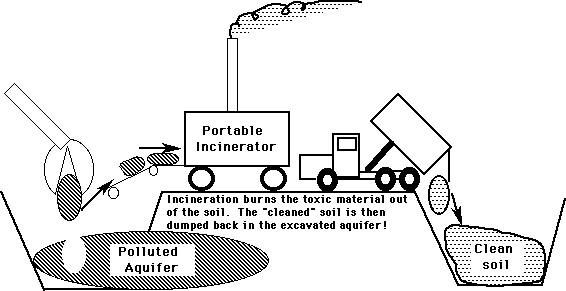Excavation & Incineration
Excavation & incineration is a successfully used method
for cleaning up toxic waste. This method involves digging up and removing
the poisoned soil from the aquifer, and then burning it at high temperatures
so that only non-toxic materials are released into the air. The toxic materials
burn in the incinerator while the soil remains behind. The clean soil can
be placed back into the ground. This method has been used in Gresham before
on Burnside Rd where a former gas station had leaking gas tanks. The ground
beneath the station was dug up and burned, removing the poisonous gasoline.
The clean soil was placed back into the ground, and a coffee shop now occupies
the site.

Cost: About $14 million/ which is about
$240 extra on each years' tax bill over a period of 10 years.
Pros
1. This method ensures that most or all of the pollutants are
removed from the ground.
2. Any water that flows through this ground in the future will
be cleaner.
3. If the polluted area is small and not too deep, then the
area can be cleaned up in a short time.
Cons
1. Buildings, streets, lakes, etc. may have to be dug up and
destroyed in order to find the pollution.
2. Because of the digging and need for large equipment, there
will be a lot of noise & dust in the neighborhood. Some of the dust could
contain toxic chemicals.
3. Accidents may happen to workers (cave ins may occur).
4. Some toxic ashes may remain after the burning. These must
be transported to a safe storage site. Stored wastes may leak over time if
not properly cared for.
5. Potential air pollution from the incineration process.
6. Possibility of toxic materials leaking from the incinerator,
or during transport to the incinerator.
7. Building a large incinerator, or buying a small portable
incinerator is a big up front cost. However, once you have it, other toxic
materials can be burned. Other cities may pay your town to use your incineration
facilities!
Links:
